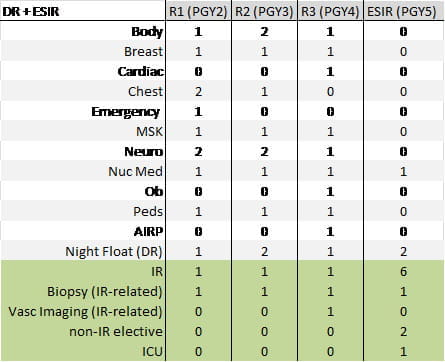The Early Specialization in Interventional Radiology residency program at the Indiana University School of Medicine is an ACGME-accredited program. Residents who have early specialization in interventional radiology (ESIR) certification can matriculate directly into the second year of an Independent Interventional Radiology (IR) Residency Program. The residency is approved to grant early specialization certification during the PGY-5 year and accepts up to three residents per year in addition to integrated and independent interventional radiology. Residents in the diagnostic radiology residency apply for acceptance into the early specialization program in spring of their PGY-3 year.
 Block Schedule
Block Schedule
With the exception of the R3 (PGY-4) year, residents have the same block schedule as other diagnostic radiology residents in PGY 2-4. In the R3 year, residents have the option to rotate through vascular imaging.
Early specialization residents have six interventional radiology rotations: biopsy, intensive care unit, nuclear medicine, and two non-IR electives. They rotate through two months of diagnostic radiology night float similar to their integrated diagnostic radiology/interventional radiology colleagues.
Residents can choose their desired non-interventional radiology related electives. Those include but are not limited to: medical oncology, radiation oncology, surgical oncology, hepatology, vascular surgery, neurosurgery, obstetrics and gynecology, transplant surgery and cardiology.

Clinic
Early specialization residents rotate through the various dedicated outpatient interventional radiology clinics, experiencing a wide variety of patient populations and disease pathology. Residents rotate through clinic for a half-day every other week throughout the entirety of their early specialization year.
Call Exposure for ESIR (R4/PGY-5)
Residents cover weekend-day float (Saturday and Sunday) paired with a PGY-6 senior resident. Early specialization residents take primary interventional radiology call in a limited fashion. Residents cover primary interventional radiology call serving as the primary operator or supervisor to the junior resident as appropriate and always in conjunction with on-call interventional radiology faculty.